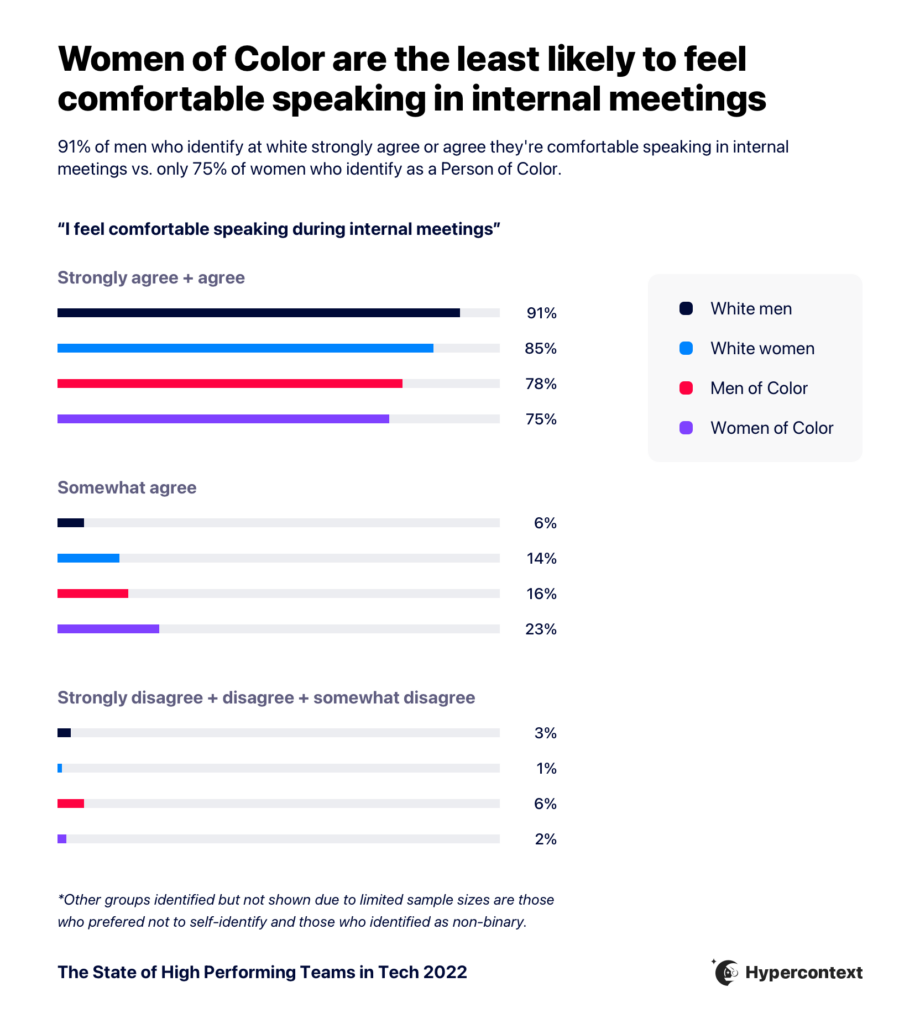Mastering the art of inclusion at a company is no easy feat. Most companies tend to have many inclusive efforts at a company-wide level, run by the HR or DEI department. These teams have made it their mandate to combat damaging power dynamics across remote, hybrid, or in-person workplaces. But there is more to be done.
To start, leaders can take a more active role in implementing inclusive meetings to ensure their teams and employees are functioning at their best.
What does being inclusive really mean?
While the role that D&I plays in a business’s success is proven, not all companies, or leaders, have a clear sense of what it is.
In reality, it’s simple: diversity is about variety in representation, and inclusion is about engagement. Extending inclusion efforts to meetings can impact your business as a whole — after all, meetings are part of your day-to-day at work. In an inclusive meeting setting, everyone can contribute, and all voices have equal weight.
When meetings are inclusive — and people feel comfortable sharing their ideas — it increases psychological safety, which according to Google is the most identifiable characteristic of a high-performing team.

How to create more inclusive meetings
Here are our 7 best tips to get started:
1. Introduce a facilitator to your meetings
Help meetings become more inclusive by appointing a new team member as the meeting facilitator for each meeting.
A facilitator is responsible for leading and guiding the conversation, ensuring it stays on track. Ideally, a facilitator creates an inclusive environment where attendees feel comfortable sharing their thoughts and opinions by ensuring people aren’t being interrupted and everyone’s given a chance to speak. Let every employee have the chance to speak especially when the meeting is virtual.
2. Build a collaborative agenda
It’s no secret: we’re big fans of a good, collaborative agenda.
They’re an inclusive leader’s secret weapon. Send out your agenda before any meeting. It can be a simple outline of topics to discuss or be more focused by sending out a specially built, recurring agenda.
Sharing the main agenda items in advance gives everyone the chance to prepare and contribute. So no one’s left feeling on the spot. It gives everyone the opportunity to add items they want to discuss to ensure they don’t get left out of the conversation. Plus, participants can add comments to the agenda in advance which is helpful for those who feel less comfortable speaking up during a meeting.
3. Listen deeply and amplify
When employees share ideas, make sure you amplify and give credit where credit is due. Amplification is vital for inclusion since people of color, women and other underrepresented groups are more likely to be dismissed or spoken over.
Further, according to our State of High Performing Teams in Tech report, people of color are less likely to feel comfortable speaking in internal meetings than white colleagues. And those who identify as women are less likely to feel comfortable speaking in meetings than men. Not to mention, Gen Z is the generation most unlikely to feel comfortable speaking in meetings compared to older generations.
If people are constantly feeling like their voices aren’t being heard, or uncomfortable sharing their thoughts, they’re eventually going to give up and disengage. As a leader, it’s your responsibility to not let this happen. Given that meetings are a place for just that — sharing, listening, innovating — they’re the perfect time to start creating a more inclusive and engaging environment.
4. Provide more than one way to contribute
Despite the hard work being done around DEI, privilege and power dynamics are still present in many workplaces. Unshockingly, it can seep into our meetings, too. Those who are more extroverted, assertive, and the majority demographic are more likely to take up air time and receive more credit. They’re also typically forgiven more often when they interrupt. Breaking this cycle requires mindfulness from the leader.
Combatting this means actively encouraging participation from those who don’t usually get the space to speak or share. Follow this great advice from Eva Jo Meyers: “no one should speak twice until everyone has spoken once.”
But, keep in mind that people have different communication styles. Speaking up during a meeting can be awkward and not everyone feels comfortable doing so. But there are also other ways to invite contributions, beyond speaking up during the meetings.

5. Build psychological safety and encourage employees to take risks
We know psychological safety changes how an employee arrives to work and how a team functions.
What does psychological safety mean? Amy Edmondson defines it as “A shared belief that the team is safe for interpersonal risk-taking.” Encouraging your whole team to share their thoughts openly can pay dividends. It can help them become more confident in being vulnerable and taking calculated risks.
Inclusivity certainly isn’t reserved for team meetings. You can and should shape your one-on-ones to be more inclusive. In fact, the trust you build in your one-on-ones will be reflected in how comfortable team members are in team meetings. It will build trust between you and your employees, encouraging them to take risks and increase psychological safety.
6. Include people who share opposing views
Speaking of sharing differing opinions, success in a business begins with embracing opposing views. But doing so respectfully and with inclusion in mind can be difficult.
Introducing new ideas, breaking bias, and challenging groupthink for optimal business outcomes should be top of your list as a leader. Building inclusive teams means inviting opposing views and encouraging healthy, respectful discussion.
7. End as strong as you start: nail the follow-up
Sometimes, the most essential part of a meeting comes after the meeting itself. How you share notes, action items, and recorded videos or transcripts can make all the difference in your next team meeting. It also allows those who could not attend or have different accommodations or considerations to stay in the know. Sharing information post-meeting gives these individuals the chance to weigh in later.










Replies to This Discussion